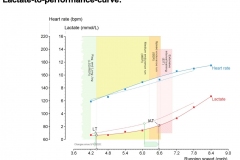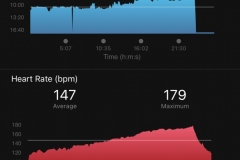Run Assessment
After a 6-week Ironman training hiatus, it’s time to update my training zones. I’ve discussed why and how they are used in previous posts (here, here here, and here). I want to be active, but still, allow for healing, so I’ve been consistently running and swimming. Before I begin serious training for Texas Ironman I need the updated zones.
Thus far the post-surgical training has mostly been focused on improving my running form through an increase in cadence. One immediate benefit of this is a reduction in the pounding and as a result, I’ve been able to run faster than I have in the past. The small improvements in pace have given me more confidence, and I’m looking forward to pushing myself harder. The run test will be my next opportunity.For the assessment, I warmed up and got started as usual. The initial pace was nice and easy which gave me the opportunity to pay attention to my form and keep my cadence close to 180. The session went very well. Although I struggled during the faster speeds, I was able to remain focused and manage my breathing and cadence. During the last interval, Johnny made me aware that my “Fred Flinstone” style resurfaced…I lean backward instead of forward. I was losing control as I struggled to keep up the pace…I was pushing beyond my comfort zone 👏🏽👏🏽👏🏽.
Changes from May 2020
The table above compares my test results from May 2020 to today. Some important improvements are seen.
- Individual anaerobic threshold improved by 0.5 MPH, 6.1 mph to 6.6 mph.
- Performance at 4 mmol/L lactate improved from 8:35/min to 8:02/min. This shows that my “base” has increased resulting in the ability to run faster without rolling over into anaerobic effort. In other words, I’ll be able to sustain a faster pace for longer periods of time.
- VO2 max improved (the maximum amount of oxygen I can utilize while exercising) Bigger is better.
- A decrease in predicted times for all running distances.
-
- 5K – 26:10.5 min to 24:41.7 min
- 10K – 57:25.4 min to 53:45.7 min
- Half marathon – 2:14:06 h. To 2:04:24 h
- Marathon – 4:55:24 h To 4:31:26 h
Looking at the improvements in times makes me marvel at the human body. For the past 6 weeks, I’ve simply worked to maintain my fitness, not improve it. I’ve also focused on how and what I eat with an eye on improving my body composition (decrease in fat) and improving the quality of foods I consume. Considering the circumstances, these changes challenge the common wisdom which says – you have to constantly go harder to get faster or stronger. In the broader athletic community, the appreciation for recovery and physiological adaptations that occur during rest is lacking.
Finally, my excitement for the improvement in predicted race times is tempered by my experience of not being mentally ready. The results above are measurements of my body alone. However, when running long or hard my mind must also be prepared for the full effort. Just because my body can physically handle 8:02 min/mile for 12 miles doesn’t mean it won’t hurt. Being prepared to mentally push through the discomfort and pain is my current “wall”. For example, during both the Houston marathon and Ironman Florida my mind succumbed to the pain. Although I was physically capable of pushing more, I was not yet mentally strong enough to endure the effort.This year, I will work to improve my mental toughness during training sessions. The only way to have the confidence that I can endure is to do it over and over again during training sessions.






